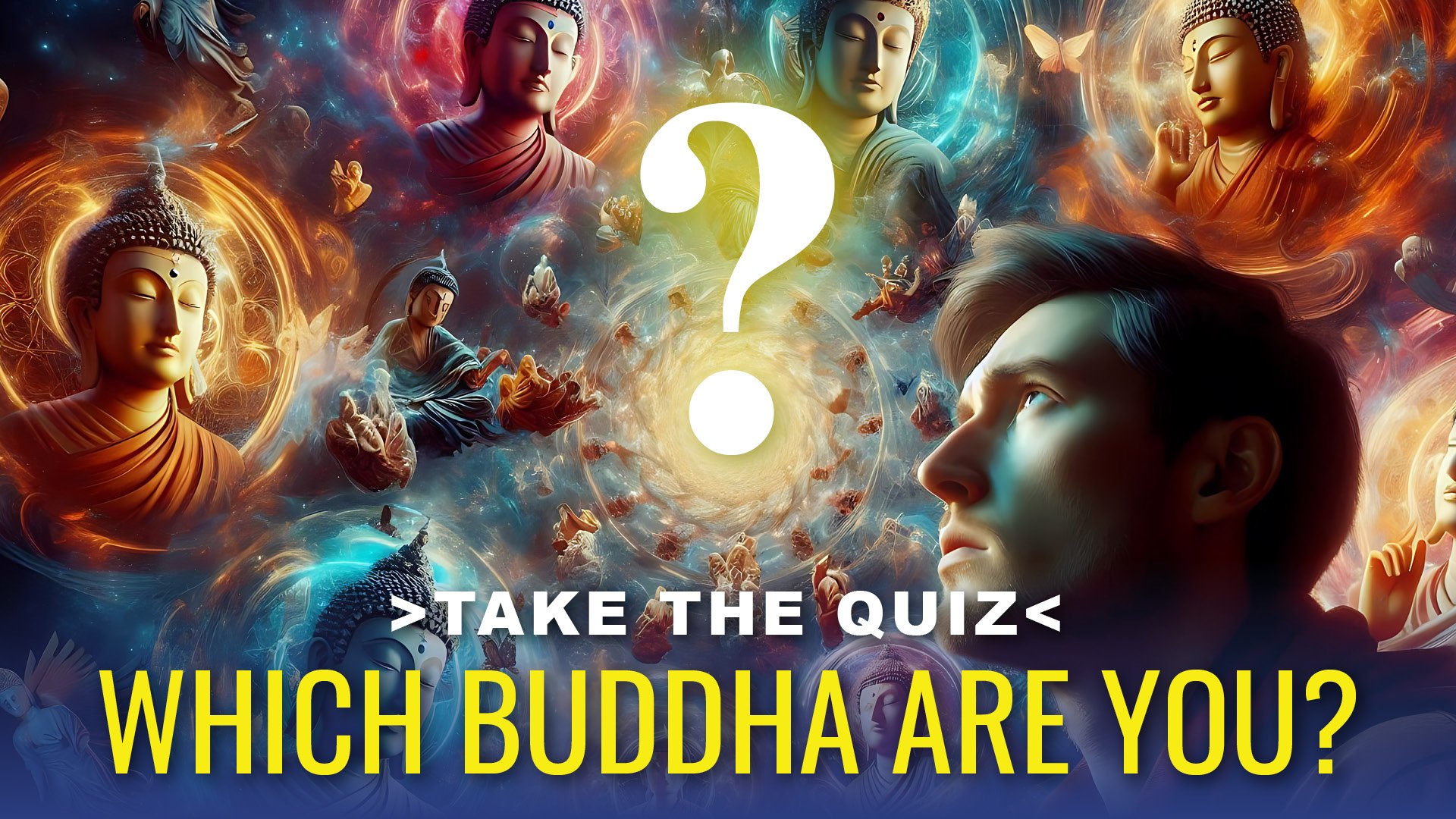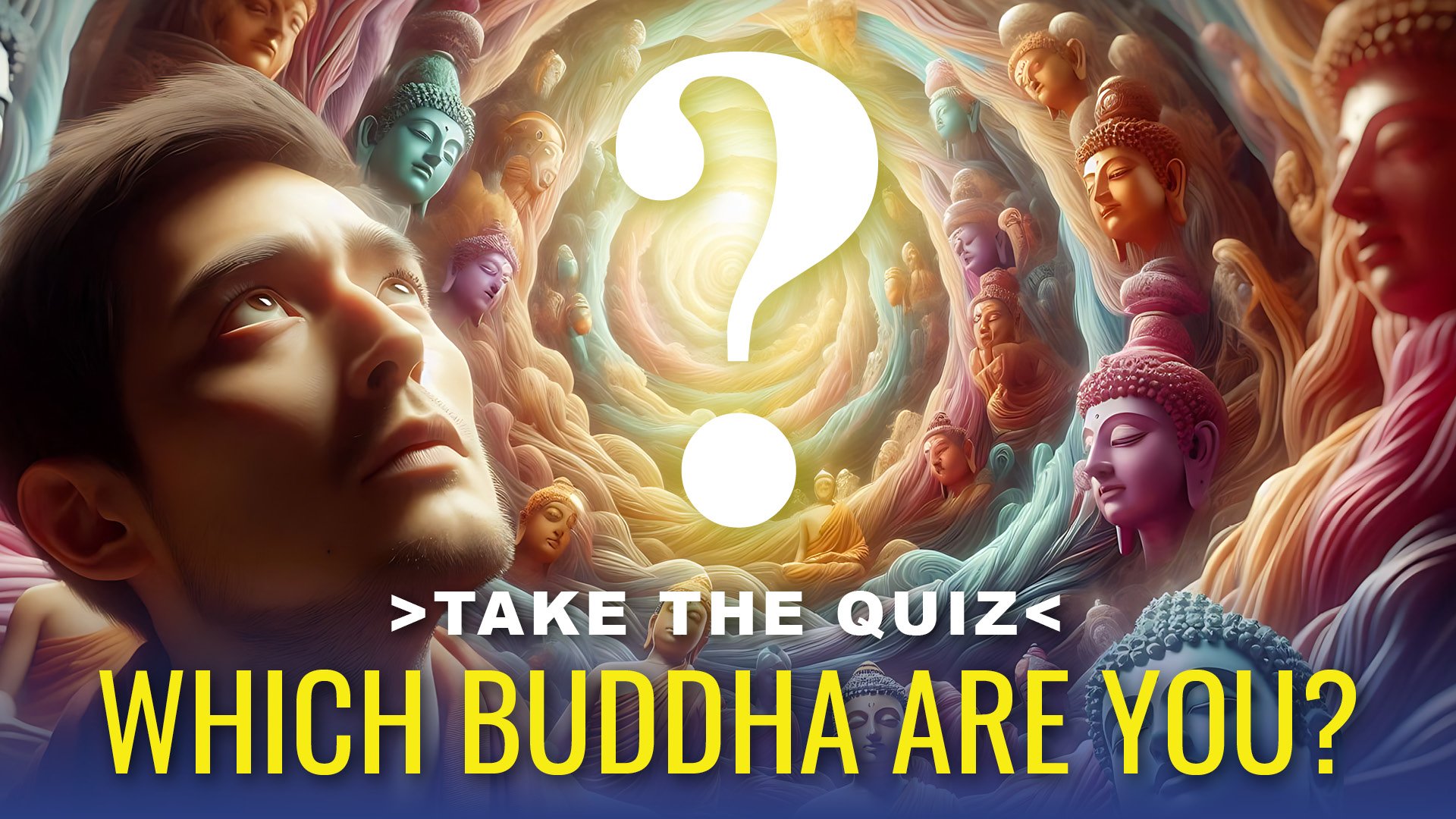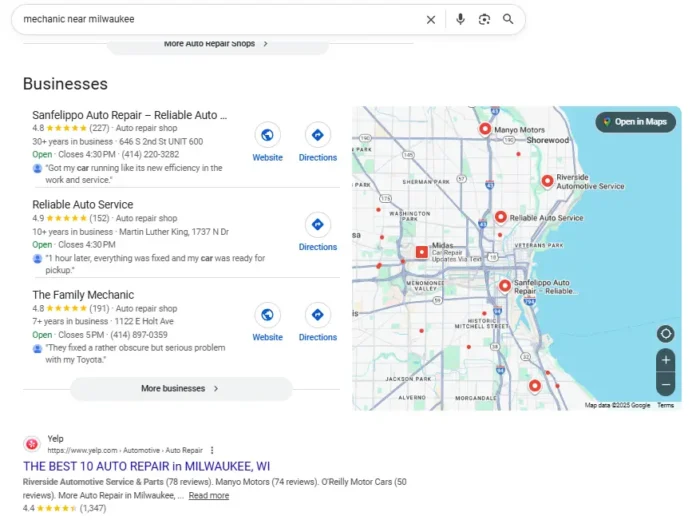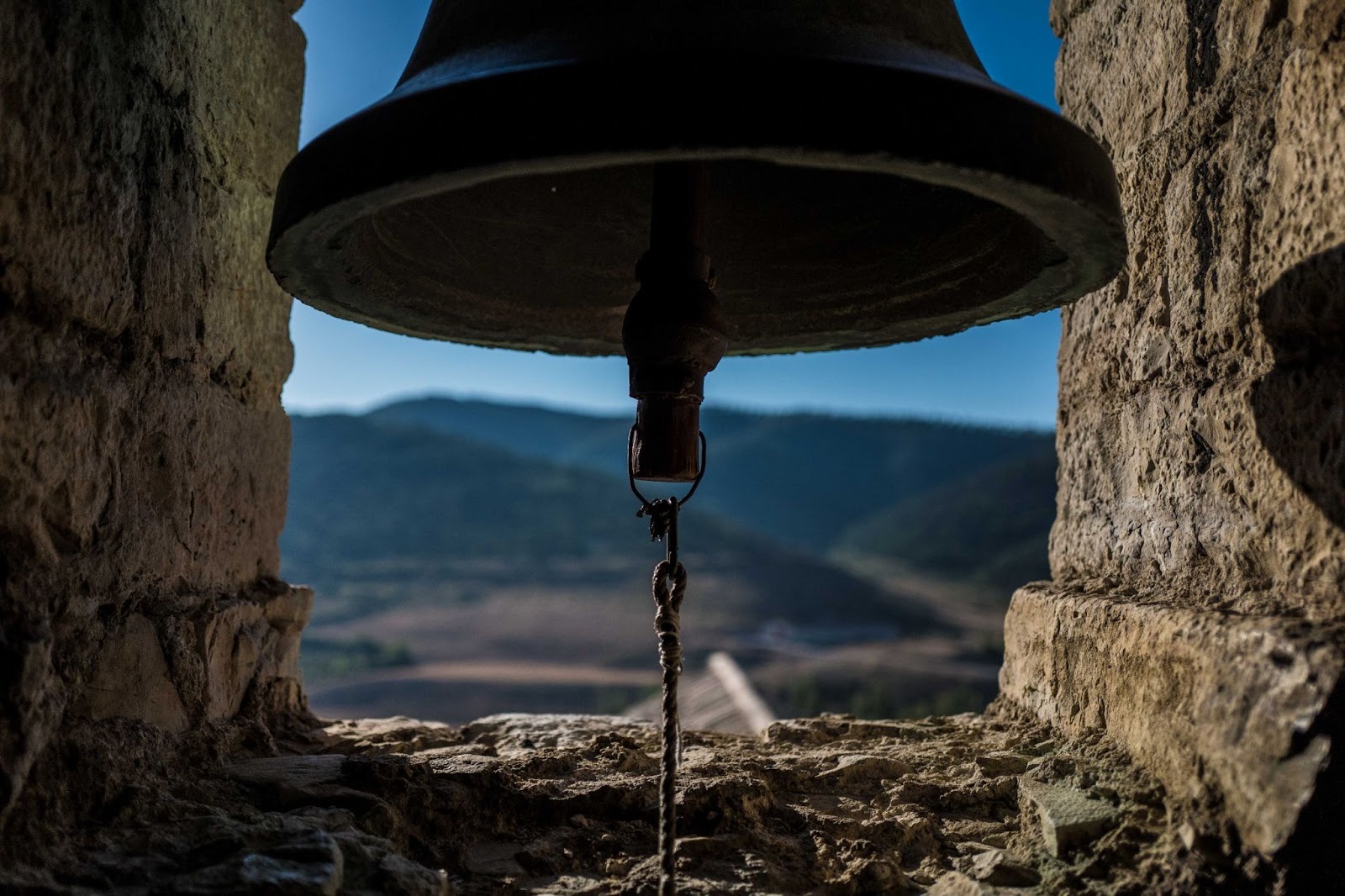Yidam Enneagram: Which Buddha Are You? 15 Questions to Unlock Your Buddha Nature?
15 Multiple Choice Questions: Unlock Enlightenment with Your Yidam Key! Which of the 25 Buddha Types are you? Why is your biggest emotional flaw also the key to your ultimate Enlightenment? What does this have to do with...

 Buddha Family Enneagram Video Thumbnail
Buddha Family Enneagram Video Thumbnail15 Multiple Choice Questions: Unlock Enlightenment with Your Yidam Key! Which of the 25 Buddha Types are you?
Why is your biggest emotional flaw also the key to your ultimate Enlightenment? What does this have to do with the Five Buddha Families and why is it like an Enneagram or psychological personality test? Which of the five Buddha families unlocks my sacred energy? How can this ancient Enneagram method help you choose your Yidam personal deity? Bookmark this video and refer to the contents, and take your time answering these 15 important questions which can tell you potentially which Yidam practice is right for you.
Video (transcript in full is below):
INSTRUCTIONS
Answer the multiple choice questions, recording the letter or number of your answer. Come back to any questions you are unsure of. See contents timecodes to review any time. Take your time. Come back to it later if you’re unsure. Tally your lettered numbers, the first 10 questions. Tally your numbered answers (the remaining 5 questions.) See the Results sections (also Timecoded below.)So, which one are you? Comment below, and let us know what you thought you were before you took the Enneagram quiz, and after.
CONTENTS
00:00-02:11 Enneagram Quiz – Which Yidam am I?
02:11-04:03 Five Buddha Families, Symbols, Practices and Carl Jung
04:03-05:46 What is a Yidam and why it focuses on our weaknesses?
05:46-08:34 Questions to ask to “discover” your “coded” practice
08:33-09:34 Question 1 — Stress Handling
09-34-10:13 Question 2 — Your ideal weekend
10:13-11:04 Question 3 — Life Motto?
11:04-12:26 Question 4 — Injured Stranger — What do you do?
12:26-13:21 Question 5 — Your favorite Scenery (visual)
13:21-14:04 Question 6 — Big Problems and Your Solution
14:04-14:52 Question 7 — Spiritual Practice Style
14:52-15:33 Question 8 — Friend in Distress
15:33-16:28 Question 9 — Favorite Color
16:28-17:13 Question 10 — Biggest Weakness
17:13-18:14 FIRST TALLY — Which Buddha Family Are You? How to calculate. What it means: weaknesses, poison, archetype, wisdom.
18:14-18:39 Archetype Energy: Buddha Family Personality
18:39-19:37 A Archetype: Buddha Family: Vairochana and Akashadhatvishvari: the Sage
19:37-20:28 B Archetype: Vajra Family of Akshobhya and Lochana: the Judge
20:28-21:24 C Archetype: Ratna Jewel Family of Ratnasambhava and Mamaki: the King
21:24-22:16 D Archetype: Padma Lotus Family of Amitabha and Pandara: the Caregiver
22:16-23:10 E Archetype: Karma Family of Amoghasiddhi and Tara: the Hero
23:10-23:50 The Members of Each Family: Mother, Buddha, Bodhisattva, Dakini, Heruka
ACTIVITY QUESTIONS
23:50-24:55 Activity Question 1 — How do you Guide or Teach Others?
24:55-26:01 Activity Question 2 — Meditation Style?
26:01-27:12 Activity Question 3 — Public Inspirational Meetings?
27:12-28:29 Activity Question 4 — How do You Cool Your Anger?
28:29-29:35 Activity Question 5 — How do you overcome Envy?
29:37-30:25 SECOND TALLY — Which Member of Your Family Are You? In section 1 you discovered which Buddha Family. In the Second Tally you discover the Yidam of the family most appropriate for you — Buddha, Mother, Bodhisattva, Dakini, or Heruka. With your results you can help answer these questions for yourself:
30:25-31:50 Which of the 25 types are You? (All 25 Scores and the Meaning)
31:50- The entire list of Enlightened members of each family and which one is right for you based on the answers to your questions.
31:45-33:35 A1-A5 Buddha Family
33:35-33:31 B1-B5 Vajra Family
33:31-34:21 C1-C5 Ratna Family
34:21-35:11 D1-D5 Padma Family
35:11-36:14 E1-E5 Karma Family
These are only guideposts. If you are strongly drawn to another family or yidam, there’s a reason for that. If you are already practicing a Yidam, did this Enneagram reinforce or contradict your choices. Why do you think that is.
These are not definitive tallies. Ultimately you decide. There are more than these 15 factors at play in your complicated life. Yet, these can be helpful signposts along the way.
We have practice resources on our channel, including some short practices, some informative videos and beautiful chanted Sanskrit mantras. As always, if you have a teacher, be guided by your lineage and teacher.
We dedicate the merit of this presentation to the cause for Enlightenment for the benefit of all sentient beings.
FULL FEATURE TRANSCRIPT:
Buddha Family Enneagram: Which Buddha Are You?
Why is your biggest emotional flaw also the key to your ultimate Enlightenment? What does this have to do with the Five Buddha Families and why is it like an Enneagram or psychological personality test? Which of the five Buddha families unlocks my sacred energy? How can this ancient Enneagram method help you choose your Yidam personal deity? We answer these questions, and more, in this Buddha Weekly feature presentation. Please like and subscribe to our channel.
Using ancient coded teachings from the Buddha can help you discover your own Yidam, your Buddha family, your life’s purpose, and even the mantra that unlocks your own potential Buddha within. If you’re not a Buddhist, it doesn’t matter, you may still discover some interesting ways of thinking about your flaws. Come along with us as we discover the practices that can unlock your own Buddha nature — and let us know in the comments what you discover.
The Five Buddha Families are an insightful mandala matrix of meditational methods. Carl Jung studied ancient Indian and Tibetan archetypes in putting together his definitive guide to personality archetypes, used today in psychology. He famously said, “The goal in psychotherapy is exactly the same as in Buddhism.” Most key ideas he discussed, such as the collective unconscious and karma, archetypes and deities, and mandalas were inspired by Tibetan Buddhist symbolism.
In this method, we tap into the science of this mandala matrix and why Shakyamuni Buddha taught this skillful method of five Buddha Families. Don’t miss our linked videos covering the five Buddha families in more detail. Before we begin your Buddha Family Enneagram, please like and subscribe to our channel, to help us Spread the Dharma.
Think of the Five Buddha Families as ancient Enneagrams. By mapping out your weaknesses and strengths, your poisons and remedies, your abilities and methods, the Five Buddha Families guide you to your perfect Yidam practice. To take this centuries-old Enneagram test, follow along with us here with pen and paper or your favorite note-keeping method.
In Vajrayana Buddhism, the notion of Yidam directly relates to these ancient Enneagrams. Yidam is just a “meditational deity” and is the key to your own personal development towards the goal of ultimate Enlightenment. Why is this? Because the Yidam focuses our meditational efforts specifically on our personal weaknesses, transforming them into opportunities for realizations or break-throughs.
Often, our teacher helps us choose our deity. When we don’t have a teacher, we might use these ancient Enneagram methods to self-discover what aspect of Buddha we most need in our lives now.
Can you guess which Buddha Family you belong to? Before you listen to the rest of this presentation, comment below with your best guess. When you finish, let us know if that changed.
What are the Five Buddha Families? All five Buddhas are Enlightened Buddhas, ultimately one. But they manifest to us, for our benefit, in different forms suited to our personality. This is why we’ve been calling it an Enneagram. The questions you can ask yourself, which we cover here in this presentation, are the very ones needed to discover your practice. If you already have a practice, this test may add to your understanding. Or, you can just have a little fun with it. Think of it as the “ultimate self-awareness’” Enneagram for Buddhists.
These five Buddha types are actually not five. Each family has five sub-types, for a total of 25.
Associated with each Buddha family is a main Buddha, who represents the specific type of Compassionate Method of that family; as well as a Wisdom Mother who represents the Wisdom of that family. We also have the Bodhisattvas and Dakinis in each family. Each family has at least one, usually more, Bodhisattvas and Dakinis. Each family also has wrathful emanations of the Buddha as well, representing more energetic aspects.
Already you can see how the personality matrix is shaping up. The coded language of Buddha, Wisdom Mother, Bodhisattva and Dakini already starts to inform us of the remedy to our situations. Once we are able to profile our Yidam from these questions, we will have a precise remedy, offered by the Buddha. This will include meditations, practices, mantras and other remedies.
Ready to explore? Ideally have a pen handy or record your answers. The version in this presentation is a shorter Buddha Family Enneagram.
We’ll start first by identifying the family you most align with. Then, we’ll set out to discover the activity aspect your align to for your needs in the family. We’ll end with a summary of each, and some resources for you to get started.
You’ll be choosing A through E for each of these multiple choices. Don’t pick the choice you wish you would make, but rather the one you know you would make in this hypothetical situation. Just record your answers for now. Don’t pause and consider. Just answer the first thing that seems right to you.
Question One deals with how you handle stress.
Answer this question: “When I’m extremely stressed to the maximum, which of the following is my primary response:
Choose “A” if “I shut down or space out.”
Choose “B” if “I tend to get frustrated or even blame others.”
Choose “C” if “I seek to escape stress with “food, shopping, or indulging.”
Choose “D” if “I compensate by reaching out charitably to help others, putting aside my own problems.”
Choose “E” if I tend to “impulsively react to the situation.”
Write down the most suitable answer. Try to record only your first instinctive answer.
Question 2 asks you to rate your ideal get-away weekend
Choose “A” for “I like to get away with a good book and some quiet meditation.”
Choose “B” for “I like to organize and plan events and celebrations.”
Choose C for “I like to host a big dinner party.”
Choose D for “My ideal weekend is helping out a friend.”
Choose E for “I like an adrenaline-packed adventure weekend!”
Do you have your answer?
Question 3 asks you to choose your life motto. Here we’re just aligning with the one closest to your philosophy. Only choose one, even if you ascribe to all of them.
Answer “A if your life motto is “I am a seeker of the truth.”
Answer B if your motto is “Logic and Justice are the most important.”
Answer C if you believe “life is a celebration!”
Answer D if you feel “love and kindness are the true secret.”
Answer E if you believe “without risk there can be no reward.”
Record your answer for later.
Question 4 is a hypothetical question, multiple choice.
“You are hiking alone in a beautiful, mystical forest, several hours from the nearest town. Your cell phone has no signal, and you have a small amount of food in a bag. There are trees in every direction. You stumble on a stranger who is injured and crying. After you calm the person down, you discover they can’t walk without help. After you make them comfortable, what do you do?”
Answer A if you “sit together under a tree and discuss your options.”
Answer B if you “climb a tree or a hill for a better vantage or view, before deciding what to do.”
Answer C if you “share your food with the injured stranger, and continue calming him or her down as you both decide what to do.”
Answer D if you “refuse to leave the injured stranger and instead limp together in the direction you believe is the right one.”
Answer E if you “tell them to stay where they are and go off on your own to get help.”
Question 5 is visual. In a moment you will see beautiful scenes.
Without over-thinking, which of the images interests you the most, choosing only one.
Answer A if you are drawn to the beautiful images of space and the cosmos.
Answer B if you are attracted to the pristine scenes of lakes and streams and beautiful oceans.
Answer C if you are most attracted to scenes of forests and wild places.
Answer D if you are drawn to the beautiful urban environments and cities.
Answer E if you are drawn to images of people enjoying sporting activities on the beach.
Question 6. “When faced with a big problem, how do you tend to solve the issue?”
Answer A for “I see the big picture, not the individual problems.”
Answer B if “I tend to be a logical problem-fixer, step-by-step.”
Answer C for “I bring people together as a team to solve a problem.”
Answer D for “I solve problems by listening and supporting others.”
Answer E for “I take charge and execute without delay.”
Question 7 covers your spiritual practice style. Which profile suits your meditation style:
Answer A for “I prefer silent meditation on the breath.”
Answer B for “I prefer analytical meditation and ritual precision.”
Answer C for “I prefer devotional practices, showing gratitude and offerings.”
Answer D for “My practice is loving kindness and service to others.”
Answer E for “I prefer yoga’s, body meditations, and self-help exercises such as Tai Chi or Qigong.
Question 8 is hypothetical. A Dear friend of yours is in severe distress or trauma. You can’t do much for them, other than offer support.
Answer A for “I sit quietly with them.”
Answer B for “I Help them to solve the problem”
Answer C for “I cook them a nice meal and treat them.”
Answer D for “We talk it out, and cry together.”
Answer E for “I distract them with an adventure.”
Question 9 relates to color.
Of these, which is your favorite, choosing the one closest to your preference:
Choose A for “My favorite color is white or silver.”
Choose B for “My favorite color is blue or cool colors.”
Choose C for “My favorite colors are golds and yellows and autumn colors
Choose D for “My favorite colors are sunset or sunrise colors and warm reds
Choose E for “My favorite color is green.”
Question 10 is very direct. Which is your big weakness?
Choose A for “I tend to have concentration issues.”
Choose B for “I tend to have anger or short-temper issues.”
Choose C for “I tend to be a little miserly. I’m not known as a generous person.”
Choose D for “I tend to need attention or I tend to become very attached to people, things and memories.”
Choose E for “I tend to envy others. I’m often jealous. Other people always seem to have more than I do.”
Now let’s look at what it all means. Tally up whether you have more As, Bs, Cs, Ds, or E’s. If you have one of each, that means something as well. Ties are meaningful, as well, since many of us have multiple needs, and sometimes we need balanced practice methods and wisdoms. If you have a strong first place and second place, view that as your “primary family” or energy” and the second place as “helpful family.”
If you tied, or were close on several, ask yourself, which family would you prefer is dominant?
We’ll explain what it all means in more detail, but for the purpose of your tally, let’s start with the archetype energy. The Buddha archetypes align with Carl Jung’s personality archetypes.
Result 1 – Which Buddha Family Are You?
So, what is your Buddha Family Personality? We have a linked video with practices, mantras and overviews of each of these families in the description and information icons.
Predominantly A’s indicates the Buddha Family of Vairochana Buddha and White Tara or Akashadatvishvari Mother. If you were comparing to Jungian well-known personality archetypes, this would be “the sage.” In this family, the main weakness, which we call poisons in Buddhism, is ignorance, or misunderstanding the true nature of reality. The main activity of this family is Pacifying. The wisdom of this family is Ultimate Truth Wisdom or Dharmakaya wisdom or understanding non-dual reality. Think of the sage, the hermit, meditating in his cave until he attains Enlightenment. Predominantly B’s indicates the Vajra family of Akshobhya Buddha and Lochana Mother. The prevailing Jungian archetype is the “judge.” This is not only the unbiased judge but also the fearless adjudicator. In this family, the main weakness, is hate or anger. The main activity of this family is Subjugating or Supressing. The wisdom of this family is Mirror-like Wisdom. Think of the judge on his bench, gavel raised, about to pass judgment to correct criminal behaviors. Predominantly C’s indicates the Jewel family of Ratnasambhava Buddha and Mamaki Mother. The prevailing Jungian archetype is the “ruler” archetype. In this family, the main weakness is greed. The main activity of this family is Enriching, which helps overcome greed. The wisdom of this family is Generosity and Equality. Think of the wise ruler of a country, kindly and giving to his subjects, who ensures the country is wisely governed and fertile. Predominantly D’s indicates the Lotus Family of Amitabha Buddha and Pandara Vashini Mother. The prevailing Jungian archetype would be the “Caregiver.” In this family, the main weakness is attachment and clinging. The main activity of this family is Magnetizing and Controlling. The wisdom of this family is Discriminating wisdom. Think of the kind and experienced care-giver, the parent or support person who is always there to help support you with discerning wisdom and compassion. Predominantly E’s indicates the Karma family of Amoghasiddhi Buddha and Tara Mother. The prevailing Jungian archetype is the “Hero.” In this family, the main weakness is envy or jealousy. The main activity of this family is heroic activity— always moving forward with positive karma. The wisdom of this family is All-Accomplishing Wisdom. Think of the hero-warrior, who protects and guards the well-being of the country.Now you know your aligned family. Get to know the Buddha Family in general. We have videos and practices on all five on our YouTube Channel.
Take your time in choosing between the Buddha of the Family, or the Mother, or their spiritual sons and daughters, the Bodhisattvas, Herukas and dakinis.
Activity Questions: Mother, Buddha, Bodhisattva, Dakini, Heruka?
To get you started in focusing on the activity aspect of your Yidam practices, here are a few more questions.
Question 1. When you are helping or teaching others, whether it’s your family, friends, or strangers, which of the following seems to align with your approach. Again, only choose one.
Answer 1 if your approach is to nurture quietly, coaching and encouraging.
Answer 2 if you tend to teach from notes, lectures and formatted lessons.
Answer 3 if you teach by demonstration and show rather than lecturing
Answer 4 if you teach hands-on, one-on-one.
Answer 5 if you tend to teach with strict discipline in all lessons.
Activity question 2. When you have time to meditate, rate your favorite method currently. If you don’t meditate in any form, or don’t know, choose answer 1.
Answer 1 if you prefer to meditate analytically.
Answer 2 if you prefer to visualize with images and colors.
Answer 3 if you work with inner body, such as chakras and channels.
Answer 4 if you prefer guided meditations step by step.
Answer 5 if you enjoy dramatizing your meditation with actions and role-playing.
Activity question 3. How does attending a group inspirational meeting, such as a puja, a church service, an online practice, or a self-development seminar make you feel:
Answer 1 if it doesn’t do anything for you or makes you sleepy.
Answer 2 if it makes you feel fulfilled.
Answer 3 if it tends to make you feel excited.
Answer 4 if it makes you feel inspired.
Answer 5 if it makes you feel powerful or empowered.
Activity question 4. When you are angry, what’s your go-to method to cool off?
Answer 1 if you “take a deep breath” and stop to think analytically about the issue.
Answer 2 if you picture yourself in the other person’s situation. Would you be angry too? Can you find a way to understand their point of view?
Answer 3 if you stop yourself and ask yourself “is it really worth getting upset over this?”
Answer 4 if you defuse immediately with logic and patience, even if it means walking away for now.
Answer 5 if you have great difficulty cooling off your anger.
Activity question 5. How do you overcome envy?
Answer 1 if you examine your feelings analytically.
Answer 2 if you remind yourself to be happy for the other person’s good fortune.
Answer 3 for carefully prepare a plan of action to achieve whatever you envy.
Answer 4 for remind yourself to be happy for others, and take immediate action and steps to improve your own situation.
Answer 5 for No matter what I do, the envy always remains, but I’m getting better at being happy for others.
Activity Results
In the same way, as the previous Enneagram, tally your results. If most of your answers are ones, you tend to be best suited to Mother or Wisdom Practices. If most of your answers are twos, you tend to be drawn to the compassionate Buddha of the family. If your answers are mostly threes, you tend towards Dakini work. Fours indicate Bodhisattva pracitce. Fives indicate the more wrathful or energetic Heruka.
We’ve covered who the family members are in other videos, but we’ll quickly review here, to make it easier to determine your result from these Enneagrams.
Now for some results!
Combined Result: Your Yidam?
Combining your results may give you an overall indication. For example, if you discovered you were an E in the first Enneagram, you lean towards Karma family.
If you answered mostly ones in the second Enneagram, your result is E1, which is Karma Family Mother. This would be Green Tara, the mother of the Karma family.
Bear in mind there are several Dakini and Bodhisattva or Heruka practices in each family lineage. The ones listed below are just the most approachable and best known only.
We have videos with chanted Sanskrit mantras of most of these on our channel, and many of these we also have concise daily practice videos.
Bear in mind that the attributions of some Bodhisattvas and Dakinis and Herukas do vary by lineage of teachings. Be guided by your own lineage and teacher.
If you answered A this is the White Buddha Family of the centre whose element is space.
A 1 would be Ākāśa Dhātvīśvarī or White Tara. A 2 would be Vairochana Buddha, the White Buddha. A 3 would be Buddha Dakini, the White Wisdom Dakini. A 4 would be Samantabhadra Bodhisattva, called the “Great Radiance” A 5 would be Heruka Yamantaka. These practices require a teacher.If you answered B, this is the Blue Vajra Family of the East, whose element is water.
B1 would be Lochana Mother. B2 would be Akshobhya Buddha, the Unshakable One. B3 would be Vajra Dakini, the Blue Wisdom Dakini. B4 would be Vajrapani Bodhisattva, the Bodhisattva of Power. B5 would be Blue Vajra Heruka or Vishuddha. These practices require a teacher.If you answered C, this is the Yellow Jewel or Ratna family of the south, whose element is earth.
C1 would be Yellow Mamaki Mother. C2 would be Ratnasambhava Buddha, the glorious, auspicious Buddha of the South. C3 would be Ratna Dakini, the Yellow Wisdom Dakini. C4 would be Kṣitigarbha Bodhisattva or Ratnapani. C5 would be Ratna Heruka.If you answered D, this is the Red Lotus Family of the West, whose element is fire.
D1 would be Pandara Vashini Lotus Mother. D2 would be Amitabha Buddha. D3 would be Padma Dakini, the red wisdom Dakini. D4 would be Avalokiteshvara or Padmapani, the glorious Bodhisattva of Compassion. D5 would be Hayagriva, the horse-head crowned wrathful aspect of compassionate Amitabha and Avalokiteshvara.If you answered E, this is the Green Karma Family of the North, whose element is wind or air.
E1 would be Arya Green Tara. E2 would be Amoghasiddhi, the Fearless Buddha. E3 would be Karma Dakini, the Green Wisdom Dakini. E4 would be Viśvapāṇi. E5 would be Vajrakilaya, the wrathful aspect of Amoghasiddhi.We have practice resources on our channel, including some short practices, some informative videos and beautiful chanted Sanskrit mantras. As always, if you have a teacher, be guided by your lineage and teacher.
We dedicate the merit of this presentation to the cause for Enlightenment for the benefit of all sentient beings.
#Enneagram #5Buddhas #BuddhaFamily #Yidam #Yidam_Deity #LifePurpose #vesak
RESOURCES:
Donor Page: Buddha Weekly
Buddha Weekly Online Magazine
Buddha Weekly – Spread the Dharma
Youtube Music: Buddha Weekly
https://music.youtube.com/channel/UCTYYSGZqKz7rH0PeAqCoM8Q
Spotify: Buddha Weekly artist
Apple Music: Buddha Weekly
https://music.apple.com/us/artist/buddha-weekly/1691780466
Amazon Music: Buddha Weekly
Buddha Weekly Patreon
https://patreon.com/buddhaweekly
HELPFUL RESOURCES

 MikeTyes
MikeTyes 






























